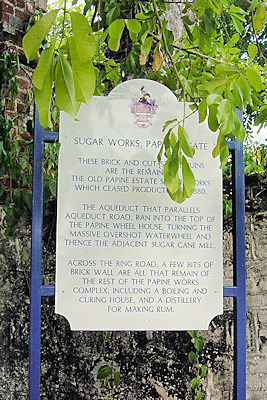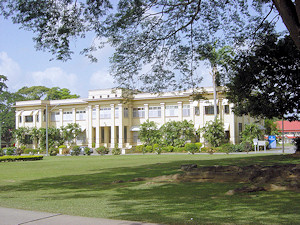The University of the West Indies

History
The University College, established in 1948 at Mona, Jamaica, was the first Campus of the University of the West Indies. Subsequently, campuses were established at St. Augustine, Trinidad (1960) and Cave Hill, Barbados (1962). Today the University of the West Indies comprises 3 main campuses, the Centre of Hotel and Tourism Management in the Bahamas, the Institute of Business at St. Augustine and Mona as well as 11 non-campus centres situated in other Caribbean countries.
Mission
The enduring mission of the UWI is to advance education and create knowledge through excellence in teaching, research, innovation, public service, intellectual leadership and outreach in order to support the inclusive (social, economic, political, cultural, environmental) development of the Caribbean region and beyond.
- Globally recognised: A university acknowledged by its peers in the global higher education community as a leading contributor in research, teaching and learning, and knowledge creation on Caribbean, small state and developing country issues. Its global reach ensures partnerships and mutually beneficial relationships with international scholars; other universities, governments and institutions; international agencies; and public and private sectors worldwide.
- Regionally integrated: The UWI is one of two regional universities in the world, with campuses and centres in sixteen English-speaking Caribbean countries. The University is dedicated to providing the highest possible quality of education and research while addressing the changing circumstances and needs of the Caribbean region. As a model for regional cooperation, the UWI remains responsive to regional and global developments. The UWI is recognised as a fully integrated regional university offering and promoting student mobility, credit transfer and the recognition of qualifications to all regional and international students. It sees the whole university as being more effective than the sum of the parts (Campuses).
- Innovative: Creation of new knowledge and the ability to adapt the University’s mission to changing environmental conditions and to be prepared to reinvent curricula to better prepare students to succeed in a global economy, as well as keeping pace with rapidly evolving technologies to ensure sustainability. Innovation also includes the products of research for commercialisation and market readiness while at the same time assisting in the resolution of the development challenges of the region.
- Internationally competitive: A university that is aligned with international benchmarking and higher education industry standards in research and undergraduate and postgraduate teaching and learning, with an increased focus on educational outcomes in a knowledge-based economy to attract high-quality students and faculty.
- Deeply rooted in all aspects of Caribbean development: A university that is responsive to regional and international needs while retaining a strong Caribbean identity and operating as a well-integrated institution working productively with all its stakeholders, and an effective agent for political, social, cultural, environmental and economic development.
- Committed to serving the diverse people of the region and beyond: A university whose graduates are sought by national, regional and global employers for their knowledge, articulation and superior problem-solving and critical/creative thinking skills.
Summary of Important Activities
The details of the different areas (teaching, publications, research and research students, scientific activities) can be found in the respective documents that are appended. However, some comments should emphasize the most important achievements.

Teaching
Over a long period of time I was teaching about 50% of the M.Sc.-programme. I developed and introduced the respective courses and tried to bring the programme onto the international level. The same applies to several undergraduate courses, particularly to the Internet-related courses. Later on other lecturers took these courses over such that I could get the possibility to develop other courses. A very important step was the introduction of the B.Sc. IT in September 2006 which is now very popular and attractive. In this programme I introduced, among others, the course "Programming for the WWW".
Research and Publications
A remarkable achievement was the book on "Logic Functions And Equations: Binary Models For Computer Science" which has been published at the end of 2004. The Springer Editor is the largest editor for Science all over the world. A second volume "Steinbach, B.; Posthoff, Ch.: Logic Functions and Equations–Examples and Exercises" was published again by Springer Science + Business Media B.V. and appeared in 2009. It emphasized particularly the computer-based education in this area. By using appropriate software and computer technology, the education of future engineers can be made much more application-oriented than ever before. No longer unimportant and small exercises done by hand in a classroom determine the education, but relevant large examples that can be solved by using large computer systems (as it is done in industrial and business environments).
Theses
This part of the document shows that over a given period of time I have been supervising most of the M.Sc. reports (among them several staff members who are now in CITS or other places on the Campus). Two very remarkable Ph.D. theses, N. Kalicharan and A. Khan, showed computer-based learning based on the local steel pan music and an expert system for the Family court.
Other activities
After the introduction of the B.Sc. IT I spent a lot of time with the design of a Centre of Scientific Computing (not an official title) on the Campus that could serve the Campus, the University as a whole, the country and even the English-speaking Caribbean. There is a growing need to connect Mathematics, Computing and Applications for a successful solution of difficult problems. A very interesting field of research is a special area of Medical Physics (the application of electrical and magnetic fields for the stimulation of blood flow), In this area I was cooperating with colleagues in Germany and in Australia.
Since 2002 I also returned to my original research fields, the connection between logics and Artificial Intelligence. Together with B. Steinbach who is now the leading force in this field we solved many problems. The highlight is the solution of a problem with the complexity of 4 324 , the coloring of grids of the size 17 x 17, 18 x 17, 18 x 18 and 12 x 21. Here you can see a description of the solution and the final result for 12 x 21 and 18 x 18. None of the rectangles that can be built by selecting two columns and two rows has the four corners with the same colour.
Member of the Caribbean Academy of Sciences, ACM, AMS, IEEE)
External Member of IKAT (University of Maastricht, The Netherlands)
In 2001 received the Vice-Chancellor's Award of Excellence.